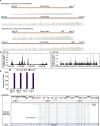TDP-43 loss and ALS-risk SNPs drive mis-splicing and depletion of UNC13A
- PMID: 35197628
- PMCID: PMC8891020
- DOI: 10.1038/s41586-022-04436-3
TDP-43 loss and ALS-risk SNPs drive mis-splicing and depletion of UNC13A
Erratum in
-
Author Correction: TDP-43 loss and ALS-risk SNPs drive mis-splicing and depletion of UNC13A.Nature. 2024 Jul;631(8020):E7. doi: 10.1038/s41586-024-07577-9. Nature. 2024. PMID: 38890465 Free PMC article. No abstract available.
Abstract
Variants of UNC13A, a critical gene for synapse function, increase the risk of amyotrophic lateral sclerosis and frontotemporal dementia1-3, two related neurodegenerative diseases defined by mislocalization of the RNA-binding protein TDP-434,5. Here we show that TDP-43 depletion induces robust inclusion of a cryptic exon in UNC13A, resulting in nonsense-mediated decay and loss of UNC13A protein. Two common intronic UNC13A polymorphisms strongly associated with amyotrophic lateral sclerosis and frontotemporal dementia risk overlap with TDP-43 binding sites. These polymorphisms potentiate cryptic exon inclusion, both in cultured cells and in brains and spinal cords from patients with these conditions. Our findings, which demonstrate a genetic link between loss of nuclear TDP-43 function and disease, reveal the mechanism by which UNC13A variants exacerbate the effects of decreased TDP-43 function. They further provide a promising therapeutic target for TDP-43 proteinopathies.
© 2022. The Author(s).
Conflict of interest statement
A patent application related to this work has been filed. The technology described in this work has been protected in the patent PCT/EP2021/084908 and UK patent 2117758.9 (patent applicant, UCL Business Ltd and NIH; status pending), in which A.-L.B., O.G.W., M.J.K., S.E.K.-H., M.E.W. and P.F. are named as inventors. The other authors declare no competing interests.
Figures














Comment in
-
Mechanism underlying a risk gene in neurodegeneration.Nature. 2022 Mar;603(7899):33-34. doi: 10.1038/d41586-022-00383-1. Nature. 2022. PMID: 35197585 No abstract available.
-
Integrating functional genomics with genetics to understand the biology of ALS and FTD.Med. 2022 Apr 8;3(4):226-227. doi: 10.1016/j.medj.2022.03.008. Med. 2022. PMID: 35590152
-
Cryptic inclusions UNCover losses driving neurodegeneration.Trends Genet. 2022 Sep;38(9):889-891. doi: 10.1016/j.tig.2022.06.004. Epub 2022 Jun 27. Trends Genet. 2022. PMID: 35773026
References
-
- van Es, M. A. et al. Genome-wide association study identifies 19p13.3 (UNC13A) and 9p21.2 as susceptibility loci for sporadic amyotrophic lateral sclerosis. Nat. Genet.41, 1083–1087 (2009). - PubMed
-
- Tan, R. H., Ke, Y. D., Ittner, L. M. & Halliday, G. M. ALS/FTLD: experimental models and reality. Acta Neuropathol.133, 177–196 (2017). - PubMed
-
- Neumann, M. et al. Ubiquitinated TDP-43 in frontotemporal lobar degeneration and amyotrophic lateral sclerosis. Science314, 130–133 (2006). - PubMed
MeSH terms
Substances
Grants and funding
- T32 GM136577/GM/NIGMS NIH HHS/United States
- MC_PC_MR/S022708/1/MRC_/Medical Research Council/United Kingdom
- R56 AG055824/AG/NIA NIH HHS/United States
- FRATTA/JAN15/946-795/MNDA_/Motor Neurone Disease Association/United Kingdom
- FC001002/WT_/Wellcome Trust/United Kingdom
- MR/R005184/1/MRC_/Medical Research Council/United Kingdom
- U01 AG068880/AG/NIA NIH HHS/United States
- 107116/Z/15/Z/WT_/Wellcome Trust/United Kingdom
- U54 NS123743/NS/NINDS NIH HHS/United States
- TURNER/OCT15/972-797/MNDA_/Motor Neurone Disease Association/United Kingdom
- MR/W005190/1/MRC_/Medical Research Council/United Kingdom
- MR/M008606/1/MRC_/Medical Research Council/United Kingdom
- MR/K018523/1/MRC_/Medical Research Council/United Kingdom
- MR/S006508/1/MRC_/Medical Research Council/United Kingdom
- MALASPINA/APR13/817-791/MNDA_/Motor Neurone Disease Association/United Kingdom
- MC_EX_MR/N501931/1/MRC_/Medical Research Council/United Kingdom
- HALLEGGER/OCT15/959-799/MNDA_/Motor Neurone Disease Association/United Kingdom
LinkOut - more resources
Full Text Sources
Other Literature Sources
Medical
Molecular Biology Databases
Research Materials
Miscellaneous

